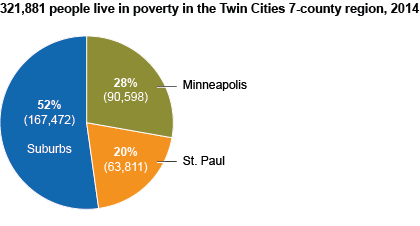A Change in Perspective
Poverty Through the Eyes of A Student
December 23, 2016
Minnesota has a population of nearly 5.3 million, Dakota County has a population of 400,000, out of those nearly 30,000 live in poverty: that’s nearly the size of the city of Apple Valley.
It’s easy to get desensitized to statistics: hearing a thousand percentages from a thousand sources can have that effect. The number of people who are living on welfare programs, unemployed, or homeless quickly loses its weight. Even among seeing the occasional person on the street as we travel through cities, many find it easier to avoid eye contact and keep walking straight past.
People are aware that poverty exists, but they often like to believe that it doesn’t exist here.
In America, poverty takes on a different shape than other places in the world: we are lucky enough to not face mass starvation, but instead mass uncertainty.
Parents come home from working double-shifts at minimum wage, uncertain of whether or not they will be able to set out a plate for each member of the family; uncertain of how they are going to fill their gas tank when it hits ‘E’ in a few days; uncertain of how to explain to their young children why they may not be able to afford some of the same things their friends’ parents can.
Nowhere does this hit closer to home than right here at Apple Valley High School. As the most culturally diverse school in District 196, the student body is an eclectic mix of powerful personal testimonies. Their stories hold more weight than any statistic ever could.
Within one minute of meeting Tavion, a 16 year-old sophomore at AVHS, it is clear that the happiness that seemed to manifest his being shines brighter than his situation. As a student whose family lives beneath the poverty line, his story is one that epitomizes the very struggle so many families face across Dakota County.
Tavion’s story starts early, with his father neglecting to be a major presence in his life, creating many questions and even a bit of resentment. Growing up without a strong male presence has undoubtedly impacted Tavion, but he chooses to not let it dictate his present.
“He doesn’t define you, he doesn’t define mom, he doesn’t define me. He is just a footnote in our history that will be long forgotten,” he shared.
For Tavion, the person he holds the most respect for is the one who has always been there for him: his mom.
“Your mom is the one who put you on earth, the least you can do is pay her back with what you can,” Tavion shared.
He works part-time at Taco Bell, and while most teenagers either spend all their money as quickly as they get it, or save it for the future, Tavion gives a majority of his earnings to his mother to help out with everyday necessities, like food and gas. “I’ve done it since before I even had a real job. When I would shovel snow for a neighbor and earned maybe 20 dollars, I would turn around and hand ten to my mom without hesitation.”
His mom relies on EBT, Electronic Benefit Transfer, an electronic system that allows state welfare programs to issue food and cash benefits. They use it to pay for food at the beginning of the month, as she is unemployed and has been for going on ten years.
Tavion and his older siblings help out where they can, but it’s not always easy. “The beginning of the month is usually good. We buy food and are set for a while, but as the month goes on, food runs low, and we just have to make do.”

Tavion’s story is all too common not only across the United States, but right here in Minnesota as well. Data from 2014 showed that over 320,000 people across the seven-county metro area were living in poverty, with over 30,000 in Dakota County alone.
There are thousands of people all around us who share stories similar to Tavion’s, but what makes his situation particularly powerful is how he has responded to his circumstances: with a joy that cannot be contained, but is spread everywhere he goes.
However, Tavion hasn’t always been the joyous character he is today: he’s struggled with depression and suicidal thoughts, at times resorting to alcohol and violence as a means of suppressing his emotions. Research suggests that these are all common responses to the situation he has been faced with. The anxiety and stress stemming from unstable housing conditions, worrying about paying bills, and bullying, among other resulting from poverty take a toll on the mental health of young people.
Yet what makes Tavion’s story particularly remarkable is how he has been able to turn his attitude around for the sole purpose of being better than who the world is expecting him to be. He went on to say, “I’m just amazed at how I’ve been able to move from such a dark place to being insanely happy, and a lot of people think I’m psycho for that.”
Tavion and his family utilize a few of the resources Apple Valley High School offers, such as the program that sends food home with students in need each weekend, and Colleen Reuvers, the school social worker, who aids students with their personal and academic needs they may not be getting anywhere else.
“When I think of Tavion, I am immediately drawn to his friendliness and personality. He is hard not to like,” Reuvers said.

Dakota County is also home to a multitude of shelters and assistance organizations, such as the Rosemount Family Resource Center and Shepherd of the Valley’s food shelf.
A common misconception is that poverty and laziness go hand in hand, many saying that “they should just get a job,” when in reality it is not that easy. Tavion’s mother has had to chose between working or taking care of her kids at home, given the incredibly high costs of child-care for Tavion and his siblings. This is just one of the many factors that contribute to complications with rising above the poverty line.
Tavion’s story serves as a reminder that poverty exists all around us; it is not exclusive to stereotypically poorer areas, and its causes are varied and complicated. But his story also shows that no matter what you have gone through, you can always chose to be greater than your circumstances.
Tavion echoes this through something he reminds his little sister of frequently: “Me and you, we can be better than who our situation is telling us to be.”
Rising above your situation isn’t always easy, but Tavion shows that it is possible: “Just never give up. No matter what happens, never give up.”

Sophia • Dec 23, 2016 at 3:26 pm
What a great article. I love Tavion’s story. Very eye opening for members of the community and students at AVHS.